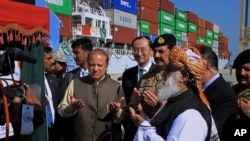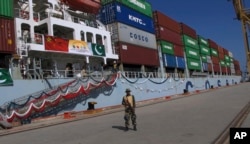Pakistan and China this week activated a new international trade route through the southwestern Pakistani port of Gwadar to showcase a multi-billion-dollar economic cooperation agreement between the two close allies.
Beijing's $46 billion investment under the China-Pakistan Economic Corridor will lead to construction of road, rail and communication networks and power projects in Pakistan along the route linking China's western Xinjiang region to Gwadar.
Chinese officials say CPEC is "the major and pilot project of the Belt and Road” initiative proposed by President Xi Jinping.
It will ultimately turn the deep water Gwadar port, developed with Chinese financial and technical assistance, into a gateway for imports and exports from Xinjiang to international markets.
The port sits at the convergence of three of the world’s most commercially important regions, the oil-rich Middle East, Central Asia and South Asia. It also lies at the mouth of the Persian Gulf, just outside the Strait of Hormuz.
Pakistani and Chinese officials gathered Sunday at the port to welcome the first convoy of trucks from China. Containers were loaded on two Chinese ships before they sailed to overseas destinations from Gwadar.
The trade convoy passed 3,000 kilometers along the Karakoram Highway through western Pakistan after entering at the Khunjerab Pass, the world's highest paved border crossing.
“It proves the connectivity of the local roads and realization of the concept of one corridor with multiple passages,” noted Chinese Ambassador to Pakistan Sun Weeding in Gwadar.
“This trade convoy is the best reflection of the spirits of mutual consultation, joint construction, mutual benefits and win-win cooperation. I believe these spirits will serve as the solid basis for the future construction of CPEC,” said the Chinese diplomat.
Pakistani leaders hope the economic corridor will bring development and prosperity to billions of people in the region.
"Pakistan is located at the intersection of three engines of growth in Asia - South Asia, China and Central Asia. CPEC will help in integrating these regions into an economic zone offering great opportunities for people of the region as well as investors from all over the world,” Prime Minister Nawaz Sharif told Sunday’s ceremony at Gwadar.
For China, the proposed CPEC route will offer the shortest possible access to the Arabian Sea and the Indian Ocean. Chinese ships currently travel through the Strait of Malacca and it takes about half a month to transport goods to or from China.
The Pakistani government is under fire at home for allegedly maintaining secrecy around CPEC-related projects and diverting much of the Chinese investment to the populous province of Punjab, a traditional stronghold of Sharif’s ruling party.
The prime minister and his spokespeople have repeatedly denied the allegations.
"CPEC is for entire Pakistan and no province and region will be left out of it. The whole nation is united and determined to make CPEC a model of success and a flagship project of Pakistan and China friendship to take our friendship to greater heights," said Sharif, while speaking in Gwadar.
Despite security and political concerns, Chinese and Pakistani officials say that CPEC-related projects have entered into full implementation and are making “remarkable progress.”
They say 16 out of 24 “early harvest projects” are under construction and expected to be completed by 2018, creating tens of thousands of new jobs for local people.
Pakistani critics, however, point to a lack of structural reforms, corruption and mismanagement in government institutions for their skepticism about CPEC.
They insist that existing infrastructure needs a major overhaul to be able to absorb pressure that CPEC-related activities will generate in the coming years.
Economist Athar Maqsood Ahmad at Islamabad’s National University of Sciences and Technology, known as NUST, says signs of improvement already exist in Pakistan, even without CPEC.
“The expected (official) growth rate with the help of CPEC is not much higher than what we have achieved on our own in the past,” he noted.
The professor said much of the public debate is based on assumptions. He said it is not possible to examine the cumulative dividends of CPEC to Pakistan because documents at relevant Chinese and Pakistani ministries do not provide the same information.








